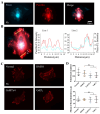α-Catenin and Piezo1 Mediate Cell Mechanical Communication via Cell Adhesions
- PMID: 38785839
- PMCID: PMC11118126
- DOI: 10.3390/biology13050357
α-Catenin and Piezo1 Mediate Cell Mechanical Communication via Cell Adhesions
Abstract
Cell-to-cell distant mechanical communication has been demonstrated using in vitro and in vivo models. However, the molecular mechanisms underlying long-range cell mechanoresponsive interactions remain to be fully elucidated. This study further examined the roles of α-Catenin and Piezo1 in traction force-induced rapid branch assembly of airway smooth muscle (ASM) cells on a Matrigel hydrogel containing type I collagen. Our findings demonstrated that siRNA-mediated downregulation of α-Catenin or Piezo1 expression or chemical inhibition of Piezo1 activity significantly reduced both directional cell movement and branch assembly. Regarding the role of N-cadherin in regulating branch assembly but not directional migration, our results further confirmed that siRNA-mediated downregulation of α-Catenin expression caused a marked reduction in focal adhesion formation, as assessed by focal Paxillin and Integrin α5 localization. These observations imply that mechanosensitive α-Catenin is involved in both cell-cell and cell-matrix adhesions. Additionally, Piezo1 partially localized in focal adhesions, which was inhibited by siRNA-mediated downregulation of α-Catenin expression. This result provides insights into the Piezo1-mediated mechanosensing of traction force on a hydrogel. Collectively, our findings highlight the significance of α-Catenin in the regulation of cell-matrix interactions and provide a possible interpretation of Piezo1-mediated mechanosensing activity at focal adhesions during cell-cell mechanical communication.
Keywords: Piezo1; cell mechanical communication; directional migration; focal adhesion; mechanotransduction; α-Catenin.
Conflict of interest statement
The authors declare no conflicts of interest.
Figures





Similar articles
-
Mechanical communication-associated cell directional migration and branching connections mediated by calcium channels, integrin β1, and N-cadherin.Front Cell Dev Biol. 2022 Aug 16;10:942058. doi: 10.3389/fcell.2022.942058. eCollection 2022. Front Cell Dev Biol. 2022. PMID: 36051439 Free PMC article.
-
α-Catenin links integrin adhesions to F-actin to regulate ECM mechanosensing and rigidity dependence.J Cell Biol. 2022 Aug 1;221(8):e202102121. doi: 10.1083/jcb.202102121. Epub 2022 Jun 2. J Cell Biol. 2022. PMID: 35652786 Free PMC article.
-
High Stretch Associated with Mechanical Ventilation Promotes Piezo1-Mediated Migration of Airway Smooth Muscle Cells.Int J Mol Sci. 2024 Feb 1;25(3):1748. doi: 10.3390/ijms25031748. Int J Mol Sci. 2024. PMID: 38339025 Free PMC article.
-
Joining forces: crosstalk between mechanosensitive PIEZO1 ion channels and integrin-mediated focal adhesions.Biochem Soc Trans. 2023 Oct 31;51(5):1897-1906. doi: 10.1042/BST20230042. Biochem Soc Trans. 2023. PMID: 37772664 Review.
-
Mechanical properties of the brain: Focus on the essential role of Piezo1-mediated mechanotransduction in the CNS.Brain Behav. 2023 Sep;13(9):e3136. doi: 10.1002/brb3.3136. Epub 2023 Jun 27. Brain Behav. 2023. PMID: 37366640 Free PMC article. Review.
References
-
- Yang C., Wang X., Xie R., Zhang Y., Xia T., Lu Y., Ye F., Zhang P., Cao T.M., Xu Y., et al. Dynamically Reconstructed Collagen Fibers for Transmitting Mechanical Signals to Assist Macrophages Tracing Breast Cancer Cells. Adv. Funct. Mater. 2023;33:2211807. doi: 10.1002/adfm.202211807. - DOI
-
- Postma M., van Haastert P.J. Mathematics of Experimentally Generated Chemoattractant Gradients. Methods Mol. Biol. 2016;1407:381–396. - PubMed
-
- Hardin C.C., Chattoraj J., Manomohan G., Colombo J., Nguyen T., Tambe D., Fredberg J.J., Birukov K., Butler J.P., Del Gado E., et al. Long-range stress transmission guides endothelial gap formation. Biochem. Biophys. Res. Commun. 2018;495:749–754. doi: 10.1016/j.bbrc.2017.11.066. - DOI - PMC - PubMed
Grants and funding
LinkOut - more resources
Full Text Sources
Research Materials

